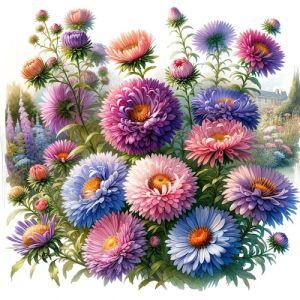Introduction
Join us on our gardening blog as we delve into the beautiful realm of asters, renowned for their lively colors and pollinator-attracting qualities. Belonging to the Asteraceae family, asters vary from quaint daisies to impressive Michaelmas daisies. Our guide offers a thorough look into growing these captivating flowers in your garden.
Aster Basics
- Common Names – Aster, Michaelmas Daisy
- Scientific Name – Asteraceae
- Family – Asteraceae
Renowned for their colorful and plentiful blooms, asters, with over 180 species, present a wide range of colors, sizes, and flowering times, making them a dynamic addition to any garden.
Botanical Overview
The distinctive feature of asters is their resemblance to daisies, characterized by a central disc surrounded by petal-like ray florets. Their chromatic range includes hues of blue, purple, pink, and white, creating a vivid palette in gardens. Asters exhibit a fascinating morphological diversity-
- Flower Structure– Each aster flower is actually a composite of smaller flowers. The central disc comprises numerous tiny, tubular disc florets, each a complete flower in itself. Surrounding these are the ray florets, often mistaken for petals, which are sterile and serve to attract pollinators.
- Foliage– Asters generally have lance-shaped, green leaves that may vary in texture and size among species.
- Root System– They possess a fibrous root system, making them resilient and adaptable to different soil conditions.
- Growth Habit– Asters range in height from compact dwarfs of just a few inches to towering varieties reaching several feet, suitable for different garden designs.
Growing Zones
These plants are hardy in USDA zones 3-8, but specific varieties may have distinct zone preferences. Selecting climate-appropriate asters is key for best growth and blooming.
Varieties of Asters
- Aster novi-belgii (New York Aster) – Known for its deep purple flowers and compact growth.
- Aster novae-angliae (New England Aster) – Boasts large, daisy-like blooms in pink, purple, and blue.
- Aster amellus (Italian Aster) – Features numerous small, daisy-like flowers in pink, blue, and white.
- Aster alpinus (Alpine Aster) – A small variety with violet-blue flowers, suitable for rock gardens.
Planting and Growth Conditions
- Sunlight- Best in full sun to partial shade, needing at least six hours of sunlight daily.
- Soil- Prefers well-drained soil with a slightly acidic to neutral pH. Amend dense soils for better drainage.
- Planting- Optimal planting times are spring or early fall. Plant in a hole larger than the root ball and water well after planting.
Care and Maintenance
- Watering- Maintain even soil moisture, especially in dry periods. Water at the plant’s base to prevent leaf diseases.
- Fertilizing- Use balanced fertilizer in early spring for healthy growth and blooming.
- Pruning- Regularly remove spent flowers and prune back stems in late fall or early spring.
Benefits and Uses
- Pollinator Attraction- Asters draw bees, butterflies, and other pollinators.
- Cut Flowers- Ideal for vibrant indoor arrangements.
- Perennial Borders- Perfect for colorful garden borders or mixed beds.
Potential Problems
- Powdery Mildew- Mitigate by improving air circulation and watering at the base.
- Aster Yellows- This disease causes stunted growth and distorted flowers. Remove affected plants to control spread.
Conclusion
Asters, with their resilience and versatility, bring elegance and color to any garden. Following this guide, you can grow healthy, vibrant asters for a stunning floral display year after year.
Frequently Asked Questions About Asters
- What are Asters? – Asters are a group of perennial plants known for their star-shaped flowers and diverse color range.
- When is the best time to plant Asters? – The ideal times are spring or early fall to allow establishment before extreme weather.
- How do I care for Asters in containers? – Ensure adequate sunlight, use well-draining soil, and water regularly while ensuring good drainage in the container.
- Are Asters deer-resistant? – They are moderately deer-resistant, but not entirely deer-proof.
- Can I divide Asters? – Yes, dividing them every few years in early spring or post-flowering helps maintain plant health.
- Do Asters attract pollinators? – Yes, they are excellent for attracting bees, butterflies, and other pollinators.
- How do I prevent powdery mildew on Asters? – Ensure good air circulation, water at the base, and use fungicides if necessary.
- What is the lifespan of Asters? – They are perennials, generally lasting many years, with 3-4 years of peak blooming.
- Can I grow Asters indoors? – They can be grown indoors with sufficient light, though they may not thrive as well as they do outdoors.
- How do I propagate Asters from seeds? – Start seeds indoors 6-8 weeks before the last frost, then transplant them outdoors once frost danger is past.
Recent Posts

The Power of Mounding: An Essential Gardening Technique for Healthy Plants

The Ultimate Guide to Philodendron Birkin – Care, Tips, and Benefits

Watering Plants – Indoor Edition

The Advantages of Built-Up Garden Beds: A Gardener’s Best Friend

The Secret Weapon for Lush Blooms: How to Create the Perfect Fertilizer Schedule










